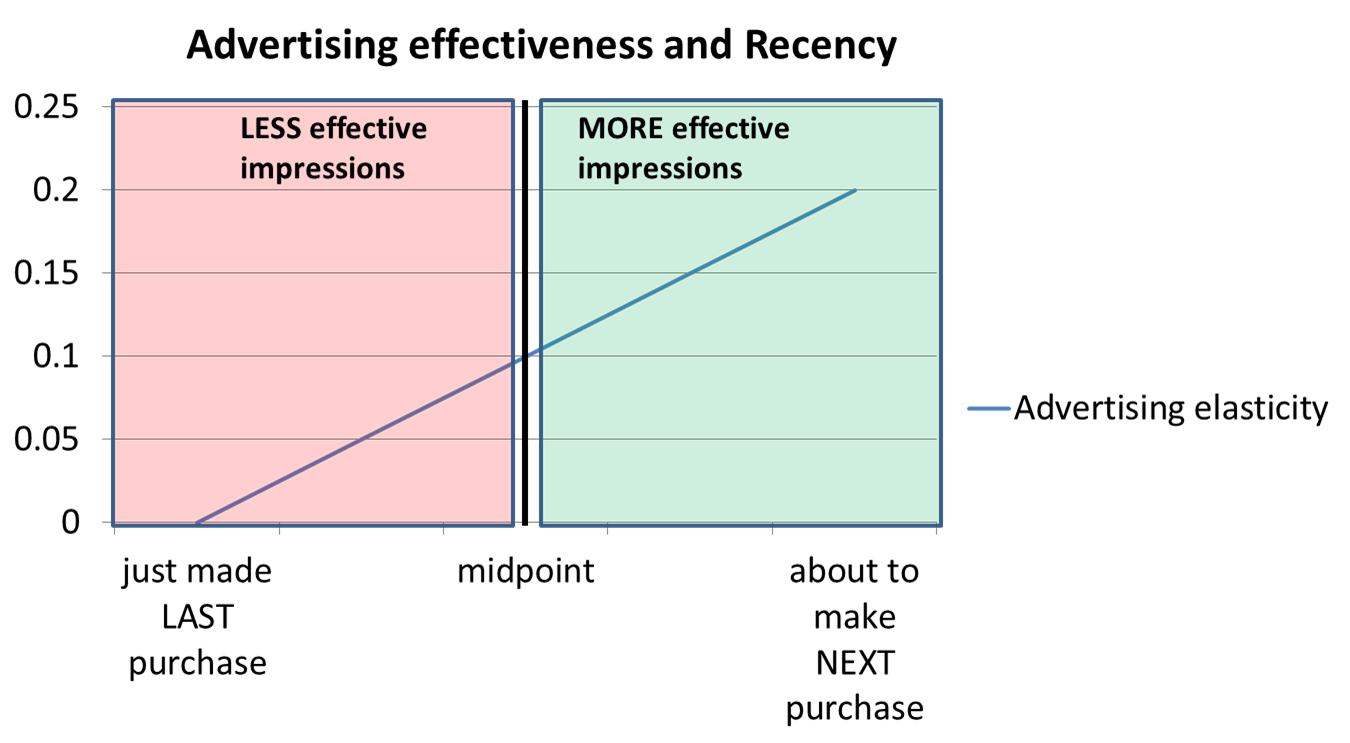Based on conclusive findings in the early 1990s that the first ad exposure has the greatest effect on sales, the concept of RECENCY PLANNING was created and has changed how media is placed. Prevailing wisdom is now that a marketer needs to stay on air consistently because, that way, it is more likely you will deliver an ad impression to someone who is about to buy than by using heavy-up pulsed flights of advertising interspersed with periods of going dark (which was the prior thinking.)
If you could, you would drop impressions selectively for each consumer closer to the next purchase than the last one. Now in the digital age, you can do exactly that.

The principle of recency implies that the sales response to ad spending (called ad elasticity in economics-speak) can be thought of as an average of no effect from the ad that is unfortunate enough to air right after a given consumer’s purchase, averaged in with twice the effect for an ad that is lucky enough to air right BEFORE the next purchase.
Why does this math matter? Because if you could find advertising vehicles that were “recency-tilted” by their nature, that is, they are more likely to deliver impressions closer to the purchase, you will get greater ad response…practically guaranteed.
“The acceptance of Recency, (or closeness to purchase), as a key variable in advertising inspired sales makes the point. The digital…messages reach the ‘readier’ to purchase consumer.” Erwin Ephron, 2011
So how do we reach the “readier” to purchase consumer? How do we recency-tilt? Digital activities that are self-directed, e.g. search or visiting a brand’s website or a site like coupons.com are mostly done with shopping purpose in mind. In other words, such digital brand communications give you recency because the consumer is controlling the timing of the impression not the marketer.
Digital display advertising can also be recency tilted if marketers change their prevailing approaches to display. Remarketing has been proven to provide greater lift and that is certainly recency tilted. Advertising served by ShareThis has been shown to provide greater conversion and it is also recency tilted because advertising is selectively served to people who share content that is relevant to them at the time, implying for many that they are about to make a purchase decision. Digital media’s ability to deliver recency will get magnified as smart mobility becomes a constant part of the shopping process.
But digital isn’t the only way to tilt the odds in your favor. Obviously, all shopper marketing is recency tilted. Another option for recency is special interest magazines in print or digital form. Especially for magazines like Car and Driver, many are buying the magazine almost as much for the ads to help a purchasing process along.
Finally, let’s think about how media and marketers calculate reach. Now, that should be adjusted also. If impressions unfortunate enough to be delivered right after the last purchase aren’t worth much, then their contribution to reach isn’t worth much either. Marketers should measure reach from those impressions delivered closer to the NEXT purchase than those closer to the LAST purchase. I want to know “recency reach”. Once you start calculating recency reach, you will find that the touchpoints that deliver this are different and it will help to guide marketers’ strategic media investment decisions in ways that will improve sales response.
With some straightforward experimentation, I believe the logical conclusions here will be confirmed. And then, the way we plan media will be profoundly affected.


Dr. Rubinson:
I am 90% on board with the points you raised, as an NPD alumnus in the old pharmaceutical pratice.
However, my observation is the Advert Elasticities windows appear to be lengthening, as a function of consumer optimism. I wonder about the correlation strength with the Michigan scores over the last three years.
Kind regards,
Thomas Calloway
New York, NY
Hi TOm:
nice to see the NPD alumni club is still operating! remember you well and hope you’re doing great
Joel,
Right on! And who can argue with Erwin.
This is also consistent with the Hendry consumer response theory as well. The goal (for established brands) is to achieve at least 1 exposure between purchase cycles for all the category buyers.
One way to do that is through a continuity plan, but this could be an expensive option for most brands.
There are other ways to plan media so that we can achieve recency without full national continuity for TV.
I would love to discuss my thoughts with you in the future.
Arthur Christiani